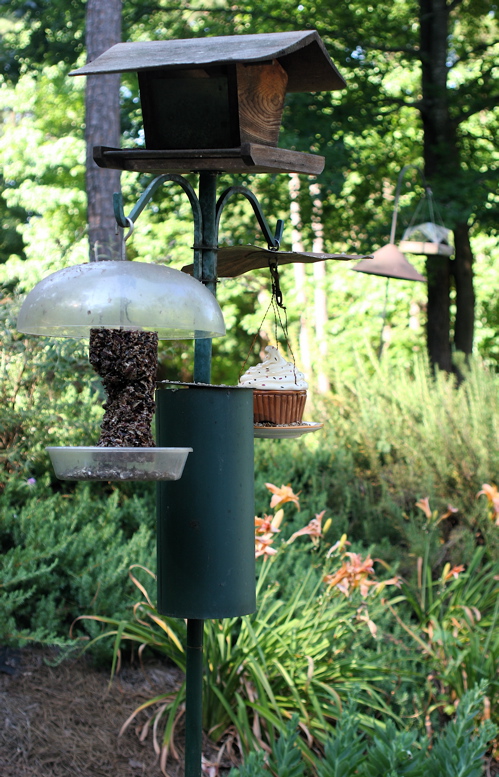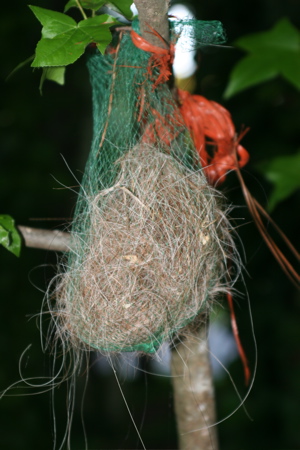-
make ant moat water last longer
If the current outdoor temperatures are any indication of the season ahead… it’s going to be a brutal one! Early June in the Southeast and my car said it was 99 degrees outside 🙁 Please be kind to wildlife by simply providing a fresh water source to help them thrive in this miserable heat. Aside from birdbaths, a leaf misters’ gentle spray is extremely popular with hummingbirds, butterflies, and most songbirds too!
Speaking of miserable, if you feed hummingbirds (or Orioles, or Butterflies) you’re likely well aware of the attraction of the sweet, sticky nectar to pesky ants. The simplest and most effective way to keep ants from nectar is to use an ant moat. This inexpensive, one-t
ime investment will save many a headache and lots of nectar from ants. For staked hummingbird feeders, ant baffles are recommended to ward off the uninvited guests.
Some hummingbird feeders do feature built-in ant moats, but even they must still contain water at all times to properly function. Ant Baffles simply use a coating of petroleum jelly on their underside to deter ants, whereas Ant Moats must have water inside for them to work. Ants can’t swim and will not cross water. During the dog days of summer with the extreme heat, you can actually help slow the evaporation process inside the moat by adding a drop of salad oil to the water. It will mean less time filling and more time watching.
-
the all-important squirrel baffle
Every single bird feeder (and even some birdhouses) at our place sits with a squirrel baffle attached to it. Don’t get me wrong, I like squirrels and feed them pretty darn good, but it’s just never enough. Squirrels are fine in the yard~just not in the bird feeders! Many folks would agree with this too.
One 3-arm feeder pole that’s next to the driveway has been the new target of our crafty critters lately, as they’ve learned to jump from the side view mirror of the car when parked near the feeder. This has caused a new plan in parking management, as the second car in is NOT allowed to pull up to the end of the drive. It’s an inconvenience, but saves a lot of birdseed!
Both hanging and pole mount squirrel baffles are essential to backyard bird feeding if squirrels happen to be present. It’s the only thing that really works. If you have a fancy shepherd’s hook with no straight end to slide the baffle over, these cone shaped ones work like a dream on any size feeder pole. A simple clamp and innovative design will make your feeders squirrel-proof in no time flat!
A customer recently told me she purchased those “hot meats” to deter squirrels. From experience I know these will work effectively… for a little while anyway. Pounds of Cayenne pepper has been added to our seed stash-but to no avail because the crafty critters get used to it. The easiest solution to squirrels is hands-down – squirrel baffles!
-
Offer Nesting Materials Many Ways
For most of April and May, we’ve been giving away free nesting materials with all orders. Throughout most of the spring season, you can encourage birds to take up residence at your place with nesting materials. Different species build their nests accordingly, so we’ve used varied materials to make up the packages.
Shown here is a Pop-Outz suet feeder, and we’ve been giving them away too! The recycled plastic makes a perfect container for offering the nesting materials. Suet is always a welcomed treat for both resident and migratory birds and the Pop-Outz is a super fun way to serve it. No-melt suet or doughs are made specifically for warm weather feeding and the energy boost really helps out migratory birds after a long journey.
But back to the nesting materials, ours were comprised of horse hair (from mane, tail and body), decorative mosses, like Spanish, sphagnum, and the yellow straw-like stuff, feathers and strips of aspen wood. Aspen fiber happens to be another favorite among North American birds, and is found in many of the commercial nesting material kits.
A mesh produce ba
g from the grocery store (like the kind apples come in) also works great for offering nesting materials, and we use them around our yard. Things like the Birdie Bell are also wonderful for nest materials, plus year-round feeding too.
Entice birds to take up residence at your place by creating a suitable and friendly environment. Food, water and shelter are the basics, be it natural or man-made… the birds will thrive and flourish!







